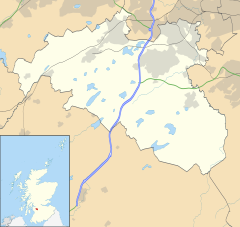Woodfarm
| Thornliebank | |
|---|---|
 Shops on Main Street |
|
| Thornliebank shown within East Renfrewshire | |
| Population | 4,051 |
| Council area | |
| Lieutenancy area | |
| Country | Scotland |
| Sovereign state | United Kingdom |
| Post town | GLASGOW |
| Postcode district | G46 |
| Dialling code | 0141 |
| Police | Scottish |
| Fire | Scottish |
| Ambulance | Scottish |
| EU Parliament | Scotland |
| UK Parliament | |
| Scottish Parliament | |
Thornliebank (Scots: Thonliebank, Scottish Gaelic: Bruach nan Dealgan) is a suburban area in East Renfrewshire, in the west central Lowlands of Scotland. Part of the Greater Glasgow conurbation, it is located on the Auldhouse Burn about 6 miles (10 km) south of Glasgow city centre, and just outside the city's administrative boundaries. The original village was founded in the 18th century and began to develop after the opening of a printworks in 1778, and subsequently other light industry. Despite industrial decline in the 20th century, Thornliebank continued to expand due to extensive public and private housing construction. As of the 2011 Census, the area has a population of 4,051.
It is not known when Thornliebank was first settled although it has been ascertained that it did not exist prior to the 18th century. The village first makes its appearance on Thomas Richardson's map of 1795 and was, at the time, referred to as 'Thorny Bank', a title believed to have been inspired by the substantial number of thorn trees that were prevalent in the area. In 1789 it was a little street of cottages but it had grown by 1845, to have a population of 1366. This was largely due to the Crum family, who established and ran the Thornliebank printworks. John Crum founded the works in Main Street in 1778 to print locally woven linen.
Walter Crum who was in charge by 1819 was a chemist and Fellow of the Royal Society. He replaced spinning and weaving by calico printing with bleaching, turkey red dyeing and "beetling". This brought immigrants from Northern Ireland and the New Statistical Account of Scotland described Thornliebank as "a very flourishing village where, thirty years ago, three families did not exist".
Walter's son Alexander Crum who took over the printing works was a major philanthropist supporting housing, education, and leisure facilities in the village. He also provided funds for the village club and Thornliebank Parish Church. Alexander Crum was Member of Parliament for Renfrewshire from 1880 to 1885. After his death he was commemorated by the Crum Library which was designed by the Scottish architect Sir Rowand Anderson and formally opened on 20 March 1897.
...
Wikipedia

